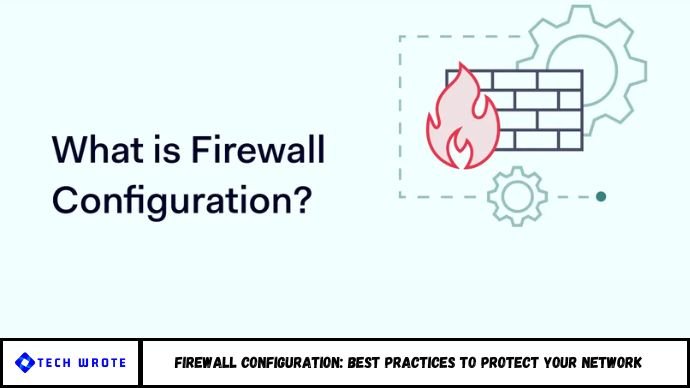Firewall configuration is a critical aspect of any organization’s cybersecurity strategy. By properly configuring a firewall, you can control incoming and outgoing traffic, block unauthorized access, and protect sensitive data. This article covers best practices, essential rules, and expert tips for configuring firewalls to improve network security and reduce vulnerabilities.
A firewall is a critical component of network security and must be properly configured to defend against data breaches and cyberattacks. Default settings alone are rarely sufficient to offer full protection.
To ensure optimal security, firewalls should be configured using specific domain names and IP address rules, tailored to your network’s structure—whether it’s public or private. By applying clear security policies and access control rules, organizations can effectively block unauthorized traffic and reduce exposure to threats such as malware, ransomware, and hacker intrusions.
Ultimately, proper firewall configuration is not optional—it’s a necessary step in creating a secure, resilient network.
Introduction: Is Your Firewall Actually Protecting You?
In today’s cyber landscape, a misconfigured firewall is as dangerous as having none at all. According to a 2024 Ponemon Institute report, nearly 40% of data breaches stemmed from poor firewall configurations or mismanaged access controls.
Whether you’re a small business owner or an IT administrator, proper firewall setup is essential for safeguarding networks from malware, ransomware, and unauthorized access. In this article, you’ll learn why firewall configuration matters, key setup tips, and how to implement rules that actually block threatsnot productivity.
1. What Is Firewall Configuration?
Firewall configuration refers to the process of setting rules and policies that control the flow of data through your network. A firewall inspects all incoming and outgoing traffic based on these rules to determine whether to allow, block, or log it.
There are two primary types:
- Network firewalls: Protect the perimeter of a network.
- Host-based firewalls: Installed on individual devices to protect internal assets.
2. Why Proper Firewall Configuration Is Critical
Improperly configured firewalls can:
- Leave open ports exposed to external threats
- Allow unauthorized access to sensitive systems
- Fail to log or detect malicious activity
Recent stats underline the urgency:
- 57% of firewall breaches occur due to overly permissive rule sets (Gartner, 2024)
- Companies that regularly audit firewall rules reduce attack surface by up to 70%
3. Key Firewall Configuration Best Practices
1. Change Default Login Credentials
Always set a strong, unique password for the firewall admin panel to prevent unauthorized access.
2. Create a Clear Policy Framework
Define your network security policy first. Decide:
- What services should be accessible?
- Which users or systems need external access?
- What types of traffic should be blocked?
3. Use the Principle of Least Privilege
Allow only the minimum access necessary for users, services, and applications to function properly.
4. Block All by Default, Then Allow Specific Traffic
Configure the firewall to deny all traffic by default, then create whitelists of trusted IPs, ports, and protocols.
5. Segment Your Network
Use Virtual LANs (VLANs) or subnetting to isolate departments or sensitive systems and limit lateral movement.
6. Enable Logging and Monitor Logs Regularly
Logs help you detect suspicious patterns, diagnose issues, and improve incident response.
7. Regularly Audit and Update Firewall Rules
Remove outdated or redundant rules. Use change management to review configurations periodically.
8. Enable Intrusion Detection or Prevention Systems (IDS/IPS)
Modern firewalls support IDS/IPS, which monitor and act against suspicious or known attack patterns.
4. Common Firewall Configuration Mistakes to Avoid
Avoid these pitfalls to keep your firewall strong and effective:
- Using “any-any” rules that allow unrestricted traffic
- Not documenting rule changes
- Allowing unused ports or open RDP/VNC services
- Forgetting to update firmware or software
- Relying on a single-layer firewall setup without endpoint protection
5. Tools and Platforms That Simplify Firewall Management
Consider these firewall management solutions for better control:
- pfSense – Open-source, highly customizable
- Cisco ASA – Enterprise-grade firewall with advanced options
- Fortinet FortiGate – Security-driven networking with deep analytics
- Azure Firewall / AWS WAF – Cloud-based protection for hybrid environments
These tools help automate policy enforcement, logging, and alerting—making configuration more scalable.
FAQs
1. What is the first step in configuring a firewall?
Start by changing default credentials and defining a clear security policy that fits your network.
2. How often should firewall rules be reviewed?
At least quarterly, or after major network changes, software updates, or incidents.
3. Can firewalls stop all cyberattacks?
No, but they’re a crucial first layer. Combine them with endpoint protection and regular patching.
4. Is a hardware or software firewall better?
It depends. Hardware firewalls are best for perimeter defense; software firewalls add control at the device level.
5. What is a common firewall misconfiguration?
Allowing overly broad access rules (e.g., “any-any”) which can leave your network exposed.
6. Do small businesses need firewall protection?
Absolutely. Small businesses are often targeted due to weak security and limited IT staff.
Conclusion
A properly configured firewall isn’t just a defense tool—it’s a strategic asset in your cybersecurity arsenal. By following these best practices, avoiding common pitfalls, and leveraging the right tools, you can greatly reduce your risk of cyberattacks and improve your network’s resilience.
Start today by auditing your current configuration and tightening rules where needed. A secure network begins with a secure firewall.


